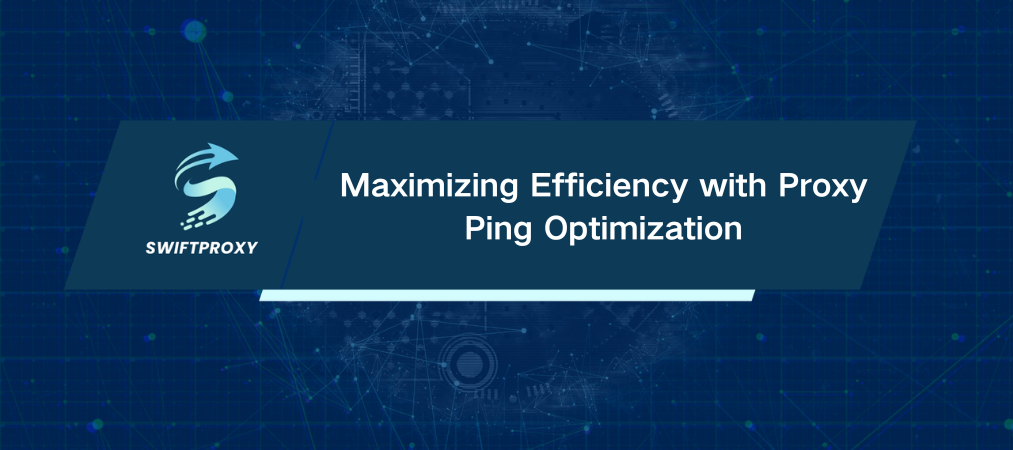Maximizing Efficiency with Proxy Ping Optimization

Let's face it—nobody likes slow connections. When you're relying on proxy servers to optimize your network, even a single delay can ruin hours of work. The good news is that mastering proxy ping testing can dramatically improve your efficiency. Whether you're scraping data, gaming, or verifying ads, the secret to faster and more reliable connections is understanding and optimizing your proxy ping.
What is Proxy Ping
In simple terms, proxy ping is the round-trip time (RTT) it takes for data to travel from your device to a proxy server and back, usually measured in milliseconds (ms). This measurement is crucial. Why? Because lower ping times mean faster connections and smoother performance.
When we talk about ping in networking, we're referring to the process of sending a small data packet (ICMP Echo Request) to an IP address and measuring the time it takes to receive a reply (ICMP Echo Reply). But when proxies are involved, this time matters even more. Your traffic is rerouted through an intermediary server, adding extra steps that increase the round-trip time. Understanding how this latency impacts your operations can help you optimize your entire network strategy.
Key Metrics You Should Know
Latency: The delay before data starts moving. Lower latency means faster response times.
Jitter: The variation in ping times. Stable, consistent pings with low jitter indicate a healthy, dependable connection.
Packet Loss: The percentage of data packets that don't reach their destination, causing delays and retransmissions.
Each of these metrics plays a role in how smoothly your proxy server will perform. When you're operating with proxy servers, even small delays can ripple out and cause significant slowdowns. Let's break it down further.
Why Proxy Ping is Crucial for Optimizing Performance
How Ping Impacts Real-World Applications
Different use cases have varying tolerance for proxy ping. Understanding this can help you focus on what's most important to you.
Web Scraping & Data Collection:
For large-scale web scraping, those extra milliseconds matter. Even a modest 50-100ms increase per request can add hours to your processing time—especially when dealing with millions of requests.
Gaming:
Lag is the enemy of any gamer. A high ping can cause frustrating delays, especially in fast-paced online games.
Ad Verification:
For those working with digital marketing and ad campaigns, slow proxy servers can mean delays in verifying ads or tracking conversions, impacting performance and ROI.
The Real Benefits of Low Proxy Ping
A low proxy ping brings tangible advantages that can elevate your entire operation:
Faster Data Retrieval: Speed is everything when you're scraping or making high-volume requests.
Reduced Risk of Timeouts: No one wants connections to fail, especially when they’re crucial.
Lower Resource Usage: Efficient use of bandwidth means you can handle more traffic without extra costs.
Higher Success Rates: With lower ping, your proxy operations are more reliable and successful.
The Hidden Dangers of High Proxy Ping
On the flip side, a high ping can spell disaster:
Slow Response Times: Your processes will take longer, and that's not just frustrating—it's inefficient.
Connection Failures: If the ping is too high, your connection might drop altogether.
Increased Resource Consumption: More delays mean more resources are used, driving up operational costs.
Performance Bottlenecks: In multi-threaded operations, a single high ping can create a bottleneck, stalling everything in its wake.
How to Optimize Proxy Ping for Better Performance
So, what can you do to improve your proxy ping and, by extension, your performance? Here are some actionable tips:
Choose the Right Proxy Server: Not all proxies are created equal. Make sure you're using a server with a low RTT to your region. The closer the server is, the better the ping.
Use Dedicated Proxies: Shared proxies are often slower due to heavy traffic. Opt for dedicated proxies to ensure consistent speed and reliability.
Test Different Proxy Locations: Ping times can vary significantly depending on where the proxy is located. Try testing multiple locations and choose the one with the lowest ping.
Monitor and Fine-Tune Your Connection: Use ping testing tools regularly to monitor your proxy's performance. Fine-tuning settings, like adjusting timeout values, can help minimize delays.
Optimize Your Network: Ensure that your local network is optimized for speed. Check for unnecessary hops or network congestion that could impact the round-trip time.
Wrapping Up
Improving your proxy ping isn't just about speed—it's about efficiency and reliability. Whether you're managing massive scraping operations, ensuring smooth gaming experiences, or verifying ads in real-time, optimizing proxy ping is essential to success.
So, the next time you notice your proxy lagging behind, remember that a few milliseconds can make all the difference. Optimize wisely, and you'll see the impact across the board.

















































